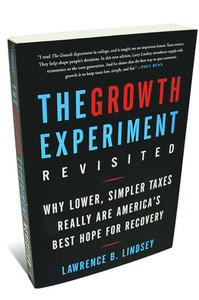Source of book image: online version of the WSJ review quoted and cited below.
(p. 15) The 1980s boom was launched on the simple insight that, by lowering tax rates and regulatory hurdles and juicing the incentives to produce, innovate and take risks, the animal spirits of the American free-enterprise system would revive. Two seminal books hatched the supply-side revolution. The first was Jude Wanniski’s “The Way the World Works” (1978); the second, George Gilder’s “Wealth and Poverty” (1981).
Almost as influential, coming a few years later, was Lawrence Lindsey’s “The Growth Experiment” (1990). Slightly academic in nature, it was the first book to quantify the economic and revenue windfall of the 1981 Reagan across-the-board tax cuts. Mr. Lindsey’s conclusion was that Reagan’s 1981 tax act quickened the pace of production, which reduced the predicted revenue loss. His research found that although the Reagan tax cuts didn’t “pay for themselves,” the ones at the highest end of the income spectrum “did produce a revenue gain” because of “changes in taxpayer behavior.” He concluded that “the core supply-side tenet–that tax rates powerfully affect the willingness of taxpayers to work, save and invest, and thereby also affect the health of the economy–won as stunning a vindication as has been seen in at least a half-century of economics.”
He has now updated his book, taking us through the booms and busts of the past 20 years. It is a valuable project in part because Mr. Lindsey was a front-seat economic adviser to George W. Bush, serving as director of the National Economic Council and as one of the architects of the often-maligned 2001 and 2003 Bush tax cuts.
Mr. Lindsey’s central claim is that those tax changes saved the economy from the undertow of the financial meltdown at the end of the Clinton presidency.
For the full review, see:
Stephen Moore. “BOOKSHELF; Book Review: ‘The Growth Experiment Revisited’ by Lawrence Lindsey; The 25 years after Reagan’s tax cuts saw unprecedented wealth creation and progress. America’s net worth exploded by $40 trillion.” The Wall Street Journal (Tues., September 10, 2013): A15.
(Note: ellipsis added.)
(Note: the online version of the review has the date September 9, 2013, and has the title “BOOKSHELF; Book Review: ‘The Growth Experiment Revisited’ by Lawrence Lindsey; The 25 years after Reagan’s tax cuts saw unprecedented wealth creation and progress. America’s net worth exploded by $40 trillion.”)
The book under review is:
Lindsey, Lawrence B. The Growth Experiment Revisited: Why Lower, Simpler Taxes Really Are America’s Best Hope for Recovery. New York: Basic Books, 2013.



The ‘quickened pace of production’ of the early Reagan years was directly attributable to RR’s massive deficit spending.
The national debt almost tripled under the watch of St. Ronnie. BO will have to work overtime to even approach this record of accomplishment.